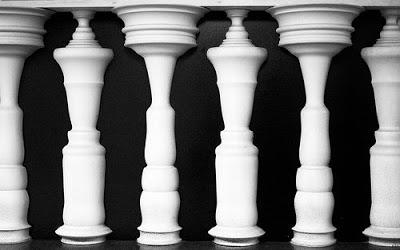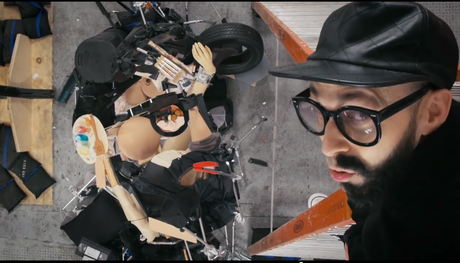The hologram is a spectacular invention of the modern era: an innocuous artefact that can miraculously generate three-dimensional imagery. Yet this modern experience has deep roots. Holograms are part of a long lineage: the ability to generate visual “shock and awe” has, in fact, been an important feature of new optical technologies over the past century and a half.
The post Holograms and the technological sublime appeared first on OUPblog.
By Siu-Lan Tan
When I saw OK Go’s ‘The Writing’s on the Wall’ video a few days ago, I was stunned. If you aren’t one of the over eight million people that has seen this viral music video yet, you’re in for a visual treat.
OK Go is known for creative videos, but this is the band’s richest musical collage of optical illusions so far. The most amazing part is that it was done … in one take!
Click here to view the embedded video.
Over 7.5 million viewers saw this extraordinary video in the first week it was posted.
And just newly released, OK Go uploaded this equally splendid video that gives us a ‘Behind-the-Scenes’ look.
Click here to view the embedded video.
Just a lucky coincidence?
OK Go posted ‘The Writing’s on the Wall’ on 17 June 2014. I wonder if they knew this is a significant date for Gestalt psychology? Important enough to be in the APA’s historical database for 17 June:
“June 17, 1924. Robert M. Ogden of Cornell University wrote to German psychologist Kurt Koffka, inviting him to become a visiting lecturer. This was the first step… that brought Gestaltists Koffka, Köhler, Wertheimer, and Lewin to America” (Street, 2007)
Wertheimer, Koffka, and Köhler are key figures in Gestalt psychology who laid the groundwork for what we know about perception, especially how we organize visual elements into meaningful wholes. Central to their work is the idea of ‘figure’ versus ‘ground’ – or how we distinguish the main focus (or figure) from the background or landscape in which it is set (ground).
They were also interested in perceptual illusions, influenced by psychologist Edgar Rubin who created many figure/ground illusions such as the Rubin vase, which now appears in every introductory psychology book.
Here’s a modern version: Are these columns or five tall standing figures with bowed heads? That depends on what you take to be figure vs. ground.

OK Go’s ‘The Writing on the Wall’ plays with figure/ground relations. Many illusions in this brilliant music video ambiguate, and then disambiguate, what is foreground versus background.
This is especially well illustrated in the illusion that “the writing’s on the wall” — as it never really is. In every appearance of the written word == in the title, the blurbs in the middle, and the amazing reveal at the end — the writing’s never on the wall.
Instead, the words blend figure and ground into single alignment. The illusion works — and then is dismantled before our eyes — as the movement of objects or camera disentangle what is foreground and background.
Figure and ground seem to dissolve into each other as the musicians emerge from the red, blue, yellow shapes.
Ambiguity of where figure and ground separate is pushed even further with single images that blend foreground with distant surfaces (floors, walls): blue spots, a network of cubes, a ladder, green checkered tiles, and a row of people that appear to stand together. It’s brilliantly captured at 02:47, in the aerial image of a multi-layered apparatus that “flattens out” into a representation of drummer Tim Nordwind’s bearded face (screenshot below).

The walkthrough also takes us through the development of art: from basic shapes, to patterns (dots, stripes), to 3D (or not) cubes, geometric sculptures, and finally to representations of the human face and full body figures.
The music is not just an accompaniment to the collage of optical illusions and paradoxes, but an integral part of the work. The song is about miscommunication that can go on in a relationship. (Or is the idea of two people really ‘getting each other’ merely an illusion?)
The result is wonderfully perplexing, a delicious trick of the senses. And a fitting tribute to the 17 June landmark in Gestalt psychology.
Siu-Lan Tan is Associate Professor of Psychology at Kalamazoo College in Michigan, USA. She is primary editor of The Psychology of Music in Multimedia (Oxford University Press 2013), the first book consolidating the research on the role of music in film, television, video games, and computers. A version of this article also appears on Psychology Today. Siu-Lan Tan also has her own blog, What Shapes Film? Read her previous blog posts.
Subscribe to the OUPblog via email or RSS.
Subscribe to only psychology articles on the OUPblog via email or RSS.
Image Credit: Optical illusion. Image by Sha Sha Chu. CC BY-NC-SA 2.0 via shashachu Flickr.
The post OK Go: Is the Writing on the Wall? appeared first on OUPblog.

 My daughter likes perusing books with visual puzzles in them, the kind where you have to find hidden creatures or hidden messages. She mentioned this to me again the other day which made me remember a book we’d bought in Edinburgh, Scotland a few years ago. Take a Closer Look: The Big Book of Optical Illusions and Visual Oddities by Keith Kay is a rich compilation of various kinds of optical illusions which you can try and figure out with your child. For the last week, my daughter and I have been going through a couple of pages every night and have been enjoying ourselves. Some of the illusions appear on Keith Kay’s website; there are some commonly known ones like the 1915 sketch by W.E. Hill of the old lady/young girl but there were also many I’d never seen before. At the back of the book, there is also an answer page which is a good thing, because sometimes no matter how hard you look, you sometimes just cannot see the thing supposedly there! Huh? I can’t see it Mom, turn to the answer page was an oft repeated refrain. There’s also a page on shadow puppetry that you can try with your hands on a wall at night — a good bedtime activity if you have a good lamp on your night stand. As much as I love reading aloud to my daughter, I do also appreciate these books where you interact with your child in a different way than just reading. Do you know of any good optical illusion books you’ve shared with your child? Let me know and I can seek them out for my daughter to enjoy!
My daughter likes perusing books with visual puzzles in them, the kind where you have to find hidden creatures or hidden messages. She mentioned this to me again the other day which made me remember a book we’d bought in Edinburgh, Scotland a few years ago. Take a Closer Look: The Big Book of Optical Illusions and Visual Oddities by Keith Kay is a rich compilation of various kinds of optical illusions which you can try and figure out with your child. For the last week, my daughter and I have been going through a couple of pages every night and have been enjoying ourselves. Some of the illusions appear on Keith Kay’s website; there are some commonly known ones like the 1915 sketch by W.E. Hill of the old lady/young girl but there were also many I’d never seen before. At the back of the book, there is also an answer page which is a good thing, because sometimes no matter how hard you look, you sometimes just cannot see the thing supposedly there! Huh? I can’t see it Mom, turn to the answer page was an oft repeated refrain. There’s also a page on shadow puppetry that you can try with your hands on a wall at night — a good bedtime activity if you have a good lamp on your night stand. As much as I love reading aloud to my daughter, I do also appreciate these books where you interact with your child in a different way than just reading. Do you know of any good optical illusion books you’ve shared with your child? Let me know and I can seek them out for my daughter to enjoy!

Dick Balzer’s collection of magic lanterns, zoetropes, thaumatropes, phenakistoscopes, and other optical toys is one of the finest in the world. He has been collecting “anything and everything invented before the movie camera that produces an optical effect” for 30 years.
The site’s boasts some new flash galleries which replicate some of the pieces’ effects (note: doesn’t seem to work in Safari).
Posted by John Martz on Drawn! The Illustration and Cartooning Blog |
Permalink |
No comments
Tags: Animation, Art History, optical illusions, Toys
This is one of the many optical illusion trucks that have been painted in Germany. So tell me...if you're a big beer drinker, what would your first instinct be? Swerve around it or try to grab on and POP the cap off? :)








Very cool.
The flash galleries work for me using Safari 4.0.3. Maybe a version issue?